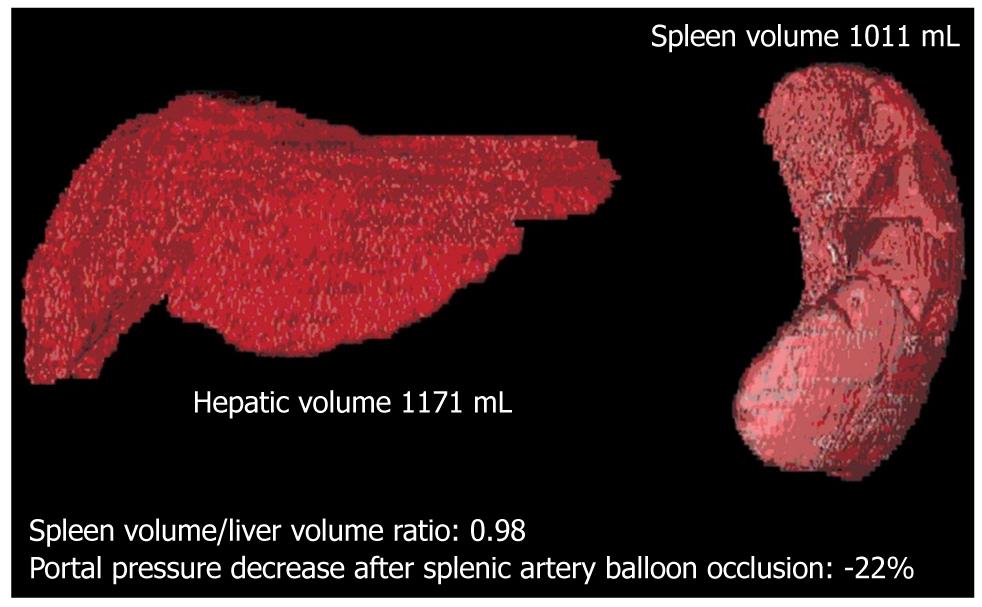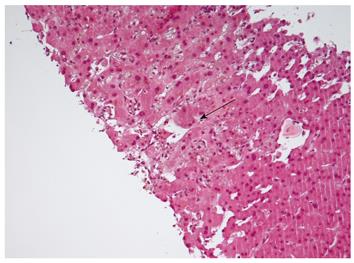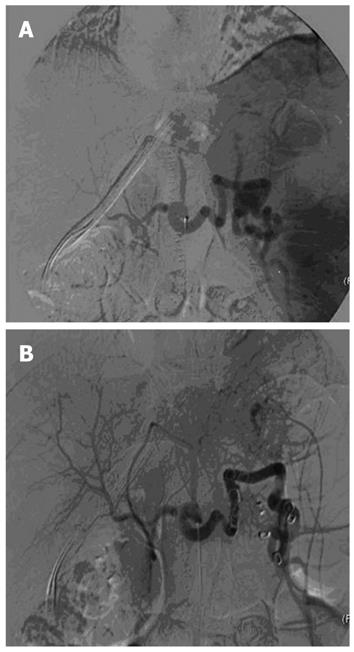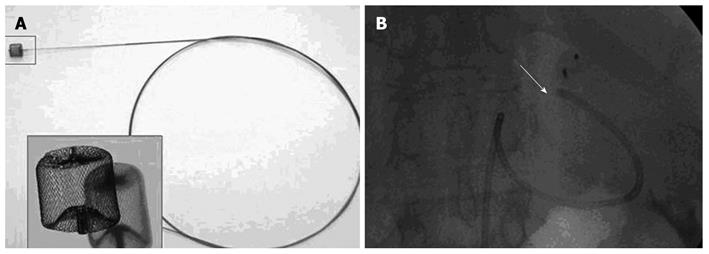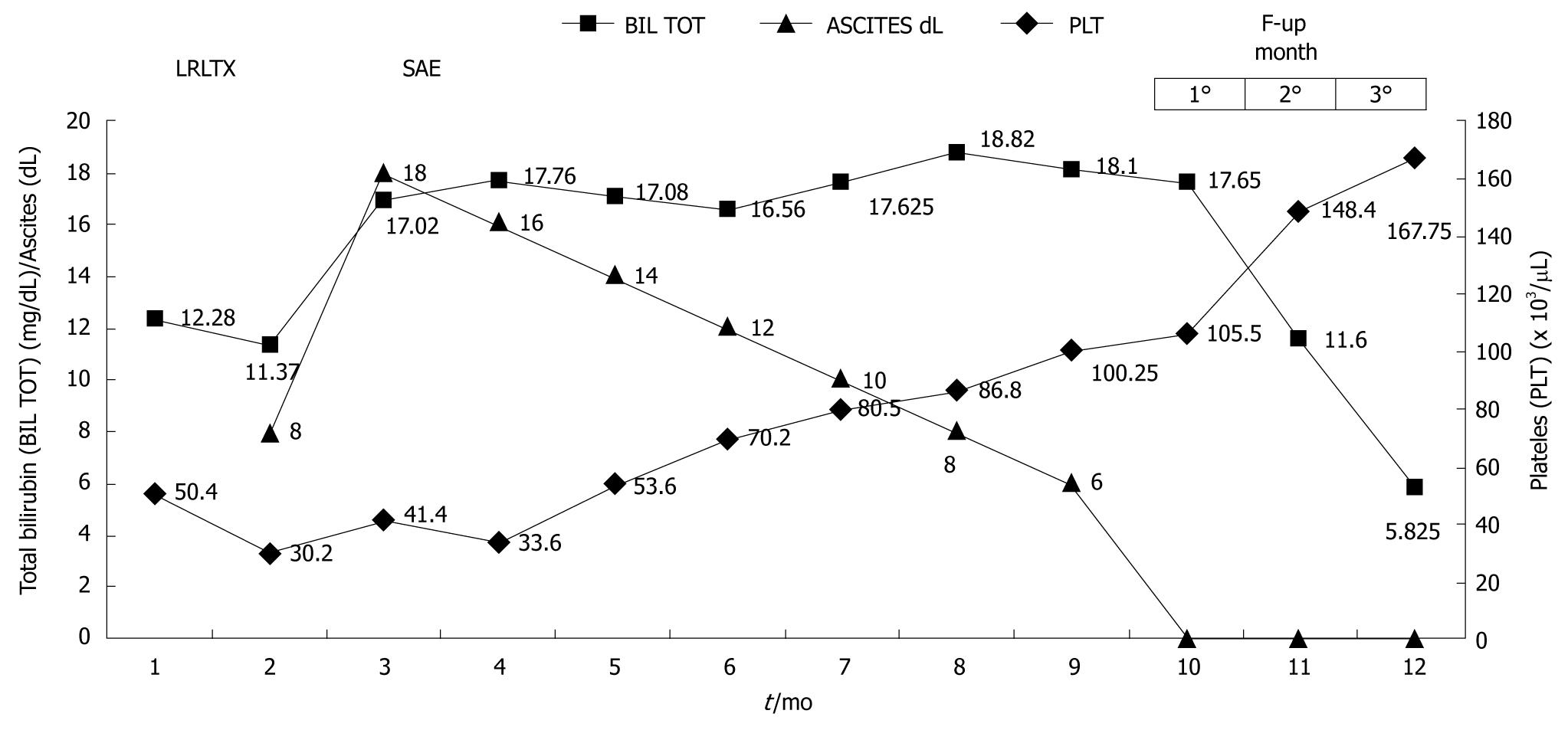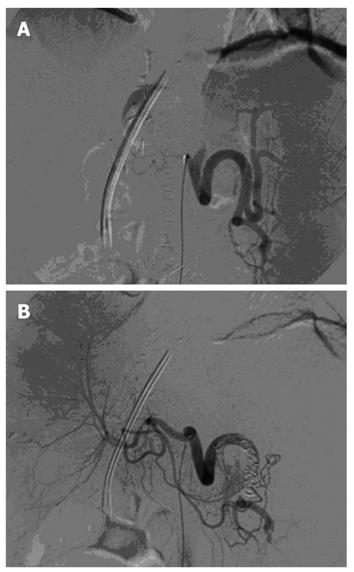Copyright
©2010 Baishideng Publishing Group Co.
World J Gastroenterol. Oct 28, 2010; 16(40): 5011-5015
Published online Oct 28, 2010. doi: 10.3748/wjg.v16.i40.5011
Published online Oct 28, 2010. doi: 10.3748/wjg.v16.i40.5011
Figure 1 Effects of splenic artery occlusion on portal pressure.
Figure 2 Correlation between spleen liver volume ratio and decrease in portal pressure after splenic artery occlusion.
P < 0.001, R = 0.82. PPG: Portal pressure gradient.
Figure 3 Clinical and histopathological manifestations of small-for-size syndrome.
The image shows centrilobular sinusoidal dilatation (arrow) and marked lobular hepatocanalicular cholestasis. Centrilobular atrophic hepatocytes can also be seen. There was moderate ductular proliferation within the portal tracts (not seen). These findings, in absence of bile duct mechanical problems, were mostly consistent with small-for-size syndrome.
Figure 4 Right lobe living-related donor liver transplantation in a 50-year-old woman with clinical diagnosis of small-for-size syndrome.
A: Celiac arteriogram shows poor filling of hepatic artery, enlarged splenic artery and splenomegaly, which suggested associated splenic artery steal syndrome; B: Celiac arteriogram after splenic artery embolization with coils showed increased hepatic artery flow.
Figure 5 Spleen necrosis treated with conservative therapy.
Post-living-related donor liver transplantation status in an 18-year-old man. Splenic artery embolization (SAE) was performed with coils and Amplatzer Vascular Plug to increase the hepatic artery blood flow after recanalization with administration of intravenous recombinant tissue plasminogen activator (rt-PA- alteplase) (case slide 23). A: Two days after SAE, multidetector computed tomography (MDCT) showed patchy areas of severe hypodensity in the spleen; B: One month after SAE, MDCT showed swelling of the spleen, with homogeneous hypodensity in almost all the parenchyma, which reflected severe necrosis; C: One year later, MDCT showed significant spontaneous reduction in spleen volume.
Figure 6 Splenic artery embolization using Amplatzer Vascular Plug.
The Amplatzer Vascular Plug (AVP) is a self-expandable occlusion device made from nitinol mesh wires. The AVP comes preloaded and attached to a stainless steel delivery cable. The AVP ranges from 4 to 16 mm in diameter, and 7-8 mm in length. The AVP is FDA-approved and is currently the embolic device that we prefer for splenic artery embolization.
Figure 7 Trend of total bilirubin, ascites, and platelet count after splenic artery embolization.
SAE: Splenic artery embolization; LRLT: Living-related donor liver transplantation.
Figure 8 Splenic artery steal syndrome.
Status after right lobe living-related donor liver transplantation for hepatitis-C- and hepatitis-B-virus-related cirrhosis in a 62-year-old woman. A: Celiac arteriogram showed enlarged splenic artery and splenomegaly with no visualization of the hepatic artery; B: Celiac arteriogram after splenic artery embolization with metallic coils showed increased hepatic arterial flow, with opacification of the intrahepatic branches.
- Citation: Gruttadauria S, Pagano D, Luca A, Gridelli B. Small-for-size syndrome in adult-to-adult living-related liver transplantation. World J Gastroenterol 2010; 16(40): 5011-5015
- URL: https://www.wjgnet.com/1007-9327/full/v16/i40/5011.htm
- DOI: https://dx.doi.org/10.3748/wjg.v16.i40.5011













